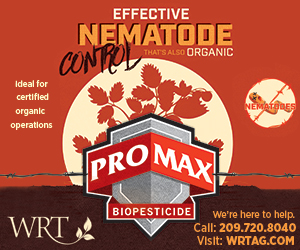
While the concept of integrated pest management (IPM) is not new, current economic considerations in almond production make these practices even more important.
UCCE Orchard Systems Advisor Franz Niederholzer said the goal of IPM is long-term pest management with economic sustainability.
“It’s a buyer’s market now, and buyers are increasingly asking about sustainable production practices.” Niederholzer said. “IPM is a key part of sustainable management.
“This is why it is even more important to re-consider and review IPM practices. The goal is to end the season in the ‘black’, with the best chance of staying there for years to come.”
IPM is a pest management strategy that first uses cultural and biological control practices followed, where needed, by careful, measured, strategic response to known pest pressure. The cultural & biological control practices work in the background, providing a safety net if active treatment does not deliver the desired pest control.
Planting decisions are key to long-term orchard health. Disease tolerant rootstocks, adequate soil drainage and planting direction make a difference in orchard health and performance.
Key practices for a strong IPM program during a growing season include: 1) Monitoring pest populations regularly, basing timely spray treatments on economic thresholds (where known) and 2) Careful spraying with materials selected to control the specific pest(s) and limit harm to non-target organisms.
Targeting diseases, Niederholzer said Sacramento Valley almond growers have less flexibility in fungicide programs due to higher disease risk under wetter conditions common in the northernmost almond growing region of the state. The best disease control is usually achieved with fungicides applied before rainfall. Focus on effective disease control early in the growing season when good spray coverage is easier to achieve and before symptoms appear. Information developed by UC plant pathologists (Adaskaveg, Gubler, Michailides) listing fungicides (conventional and organic,) their efficacy and key use timings is available at UC IPM.
Insect control with IPM can be challenging, especially for pests with limited biological control options including navel orangeworm (NOW) and leaffooted bugs. Cultural control practices including orchard sanitation and harvest timing are key to NOW control in a solid IPM program.
“You can’t spray your way out of long-term problems. Cultural and biological control practices in an IPM program are critical to effective pest control and delivering a product the market wants,” Niederholzer said.























